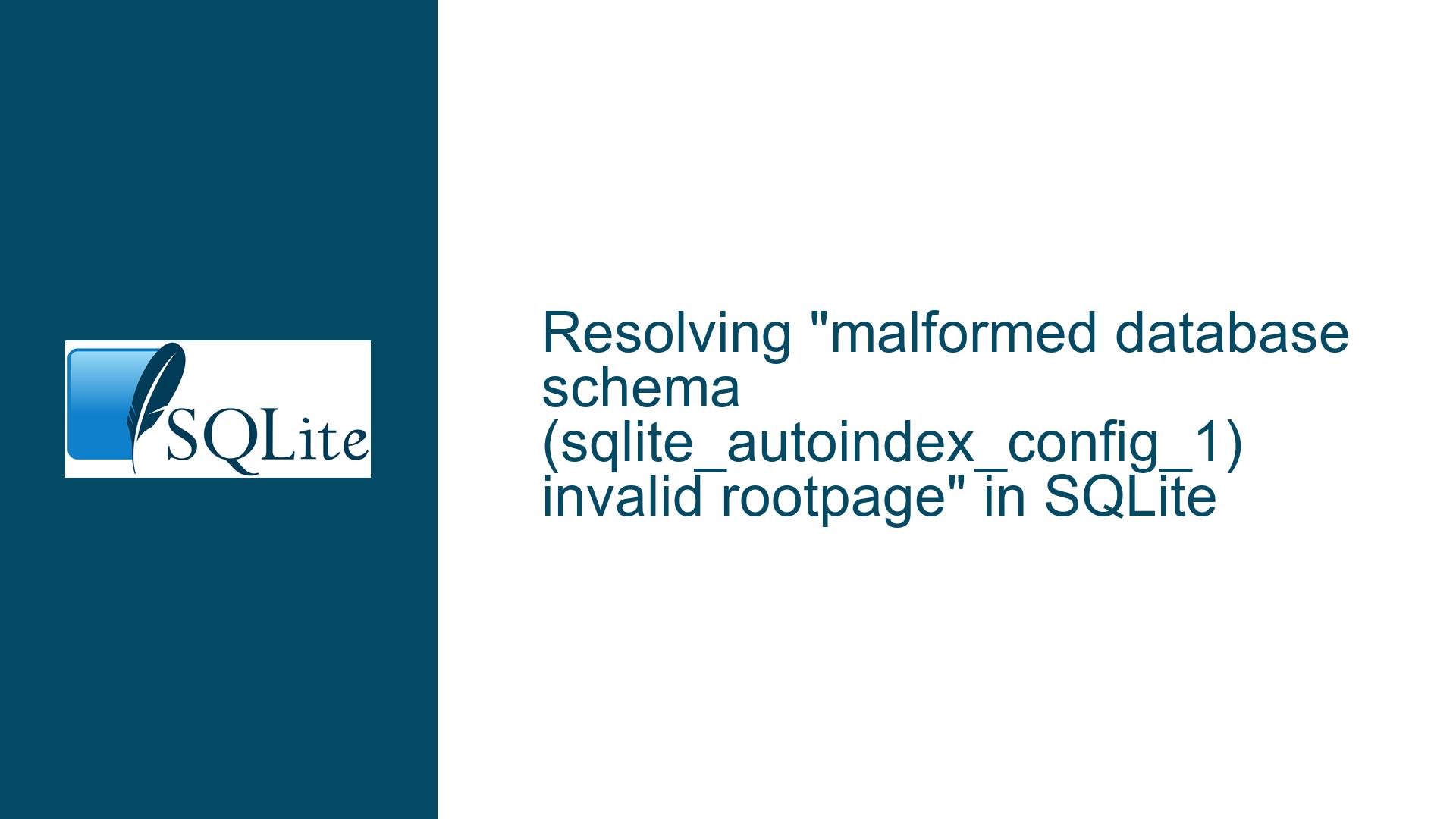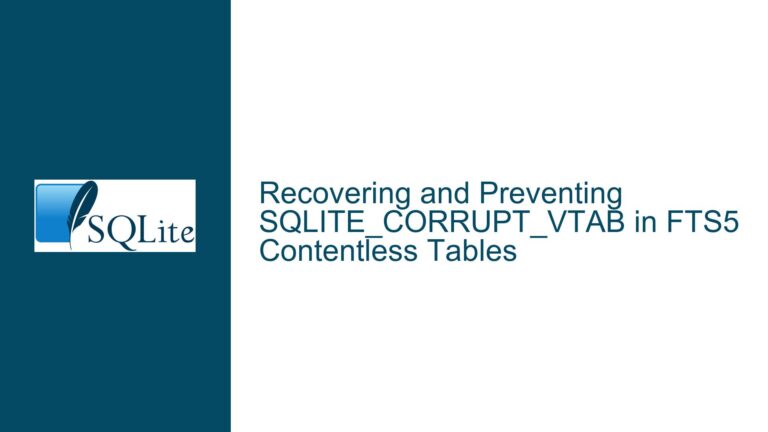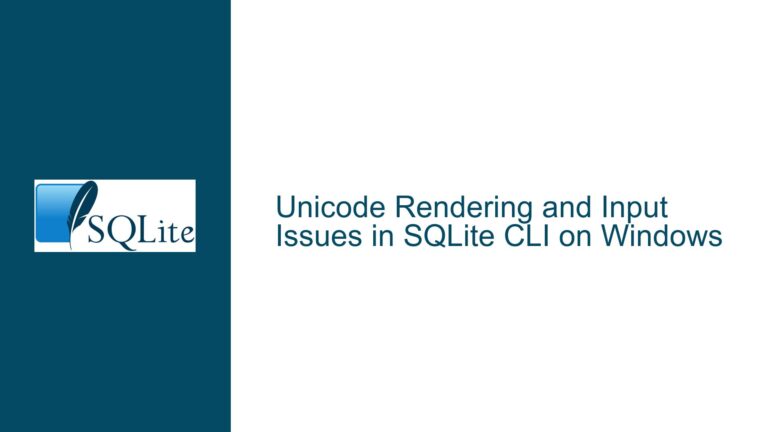Resolving “malformed database schema (sqlite_autoindex_config_1) invalid rootpage” in SQLite
Understanding SQLite Autoindex Corruption and Invalid Rootpage Errors
Rootpage Corruption in Implicit Indexes: Schema Validation Failures
The error message "malformed database schema (sqlite_autoindex_config_1) invalid rootpage" indicates that SQLite encountered a structural inconsistency in the database schema while attempting to validate an implicitly generated index. This error is triggered during schema parsing, specifically when SQLite verifies the integrity of the sqlite_autoindex_config_1 index associated with the config table’s primary key. The rootpage value stored in the sqlite_schema table for this index points to a non-existent or invalid page in the database file. This page is expected to contain the root node of the index’s B-tree structure. When SQLite cannot locate or validate this page, it raises the error, halting further operations to prevent data corruption.
The sqlite_autoindex_config_1 index is automatically created by SQLite to enforce the PRIMARY KEY(Section, Key) constraint. Unlike explicit indexes, autoindexes are managed internally and derive their structure from the table’s schema. The rootpage is a critical metadata value that defines where the index’s B-tree starts in the database file. If this value is corrupted or points outside the valid range of pages, SQLite’s schema parser rejects the entire schema entry. This issue often arises in environments where low-level storage or memory management anomalies occur, such as embedded systems with constrained resources or custom VFS implementations.
Key factors influencing this error include the integrity of the database file, the correctness of SQLite’s metadata handling, and potential interference from the application layer (e.g., improper transaction handling or memory overflows). The error may manifest during table creation if the schema update process is interrupted or if the storage layer fails to commit changes atomically. In embedded systems, hardware limitations such as insufficient power during write operations or flash memory wear-leveling quirks can exacerbate these issues.
Diagnosing Storage Layer Anomalies and Schema Parsing Failures
The invalid rootpage error is symptomatic of deeper issues in the interaction between SQLite, the application, and the underlying storage system. To resolve it, we must systematically eliminate potential causes:
Database File Corruption:
The most direct cause is physical corruption of the database file, particularly in thesqlite_schematable or the pages referenced by it. Corruption can occur due to incomplete writes, filesystem errors, or hardware faults. In embedded systems, abrupt power loss during write operations is a common culprit. The autoindex’s rootpage entry might reference a page that was never properly initialized or was overwritten by unrelated data.SQLite Version or Build-Specific Bugs:
Older versions of SQLite (pre-3.37.0, for example) contained edge-case bugs related to schema initialization and autoindex management. If the embedded system uses a custom build of SQLite or an outdated version, it might mishandle the creation of implicit indexes, leading to invalid rootpage values. Additionally, compiler optimizations or platform-specific quirks in the embedded environment could alter SQLite’s behavior.Custom VFS or Filesystem Incompatibilities:
SQLite’s Virtual File System (VFS) layer abstracts low-level file operations. If the embedded system uses a non-standard VFS (e.g., one designed for flash storage or read-only databases), improper implementation of atomic commit or rollback mechanisms could leave the database in an inconsistent state. For instance, a VFS that does not support byte-range locking might allow concurrent writes to corrupt the schema.Memory Corruption in the Application:
As noted in the discussion, memory mismanagement in the application—such as buffer overflows, use-after-free errors, or heap corruption—can propagate into SQLite’s internal structures. If the application overwrites the memory regions where SQLite caches schema data or manages page mappings, it may inadvertently write invalid rootpage values to the database.Incomplete Schema Initialization:
TheCREATE TABLEstatement might be interrupted before SQLite finalizes the schema update. For example, if the application crashes or is terminated after writing the table definition tosqlite_schemabut before initializing the index’s rootpage, the schema will reference a non-existent page. This scenario is more likely in systems without proper transaction boundaries or those that disable journaling for performance reasons.
Comprehensive Recovery and Prevention Strategies
Step 1: Validate Database Integrity and Isolate Corruption
Begin by running the PRAGMA integrity_check; command on the database. This will scan all pages and indexes for structural inconsistencies. If the check reports errors, proceed with exporting intact data using .dump in the SQLite CLI. For severely corrupted databases, tools like sqlite3_analyzer or third-party recovery software may reconstruct the schema. If the corruption is isolated to the sqlite_autoindex_config_1 entry, manually repairing the sqlite_schema table might be feasible:
-- WARNING: Direct manipulation of sqlite_schema is risky. Backup first.
UPDATE sqlite_schema
SET rootpage = (SELECT rootpage FROM sqlite_schema WHERE name = 'config')
WHERE name = 'sqlite_autoindex_config_1';
This sets the autoindex’s rootpage to match the table’s rootpage—a temporary workaround, not a fix. Rebuilding the database is safer.
Step 2: Audit SQLite Version and Build Configuration
Verify the SQLite version in the embedded system using SELECT sqlite_version();. Cross-reference this with the changelog to identify fixed bugs related to autoindexes. If outdated, upgrade to a newer version. For custom builds, ensure that options like -DSQLITE_ENABLE_UPDATE_DELETE_LIMIT or -DSQLITE_OMIT_AUTOINIT are not altering schema handling. Recompile SQLite with debugging symbols and run the application under Valgrind or similar tools to detect memory errors.
Step 3: Stress-Test the Storage Layer and VFS
Simulate the CREATE TABLE operation under controlled conditions to isolate filesystem issues. Use a different VFS (e.g., the default unix or win32 VFS) to rule out custom implementations. Monitor file I/O with strace or dtrace to ensure writes to the database file and journal are atomic. For flash-based storage, confirm that the sector size and alignment match the filesystem’s expectations. Enable full disk synchronization with PRAGMA synchronous = FULL; during testing.
Step 4: Implement Defensive Application Practices
Modify the application to wrap schema changes in explicit transactions:
sqlite3_exec(db, "BEGIN EXCLUSIVE;", 0, 0, 0);
sqlite3_exec(db, "CREATE TABLE ...", 0, 0, &err);
if (err) {
sqlite3_exec(db, "ROLLBACK;", 0, 0, 0);
} else {
sqlite3_exec(db, "COMMIT;", 0, 0, 0);
}
This ensures that incomplete schema changes are rolled back. Additionally, instrument the application with boundary checkers (e.g., AddressSanitizer) to detect memory corruption. Avoid sharing database connections across threads without proper mutexing.
Step 5: Migrate to Explicit Indexes and Strengthen Schema Design
To bypass autoindex-related issues, replace the implicit primary key index with an explicit one:
CREATE TABLE IF NOT EXISTS config(
Section TEXT COLLATE NOCASE,
Key TEXT COLLATE NOCASE,
Value BLOB,
UNIQUE(Section, Key)
);
CREATE INDEX IF NOT EXISTS idx_config_section_key ON config(Section, Key);
While this adds redundancy, it grants finer control over index creation and allows for REINDEX commands if corruption occurs. For critical systems, consider using WITHOUT ROWID tables to co-locate data and index pages, reducing opportunities for inconsistency.
By methodically addressing storage reliability, SQLite configuration, and application robustness, developers can mitigate rootpage corruption errors and ensure stable database operation in embedded environments.






